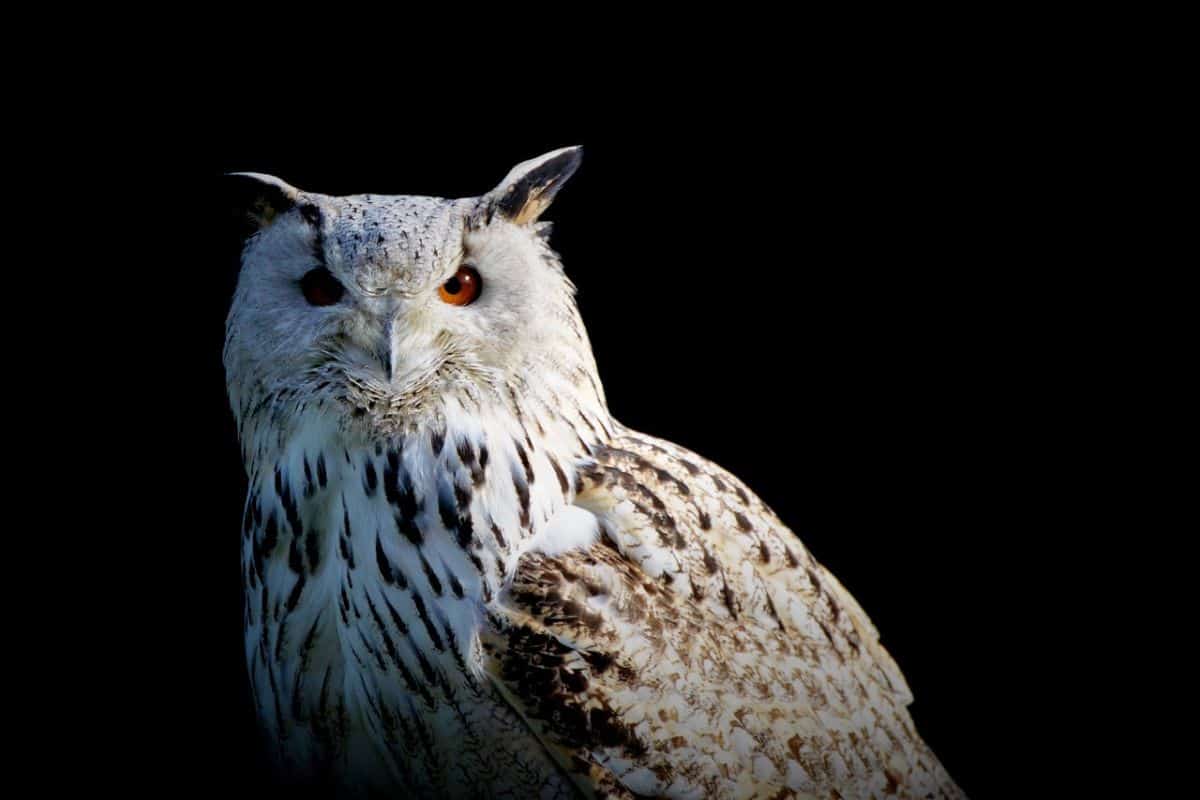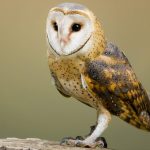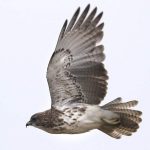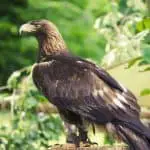Common Name: Snowy Owl
Scientific Name: (Bubo scandiacus)| Size | Diet | Range in Hawaii | Status in Hawaii |
|---|---|---|---|
| 20 in. - 28 in. | lemmings, rabbits, voles and hares | O'ahu | Vulnerable |
The Snowy Owl (Bubo scandiacus) is a magnificent bird of prey that is known for its striking white plumage and piercing yellow eyes. Native to the Arctic regions of North America and Eurasia, this owl is a rare sight outside of its natural habitat.
However, Snowy Owls have been spotted occasionally in Hawaii, making for a rare and exciting sighting for bird enthusiasts on the islands. In this article, we’ll explore the fascinating world of the Snowy Owl and learn more about its unexpected presence in Hawaii.
Snowy Owl
Appearance
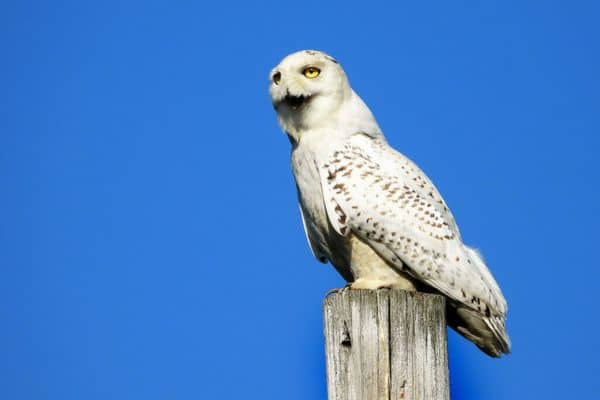
The Snowy Owl is a majestic and distinctive bird known for its beautiful appearance. It has a large, round head with bright yellow eyes. Both males and females showcase dense, white feathers that cover their entire body, including their wings and tail.
Adult males usually measure between 20-28 inches (50-71 cm) in length and have a wingspan of around 4.2-4.8 feet (130-150 cm). Females are slightly larger, reaching lengths of 22-28 inches (56-71 cm) and possessing a similar wingspan. These measurements make Snowy Owls one of the largest owl species in the world.
Diet
The Snowy Owl has a varied and opportunistic diet. As skilled predators, they primarily feed on small mammals, with lemmings being their favored prey.
However, their diet also includes rodents like mice and voles, as well as rabbits, hares, and occasionally birds. They are capable of capturing and consuming prey larger than themselves, making them formidable hunters in their Arctic habitats.
Nesting
Snowy Owls exhibit unique nesting behaviors. They are ground nesters, which means they do not build nests in trees like many other owl species. Instead, they create their nests directly on the ground, typically on elevated areas such as mounds or rock outcrops.
The female Snowy Owl prepares the nest by scraping a shallow depression and lining it with available materials like feathers, moss, and vegetation. They usually lay a clutch of 3 to 11 eggs, with the average being around 5 eggs. The incubation period lasts for about 32 to 34 days, during which both the male and female take turns incubating the eggs.
After hatching, the young owlets remain in the nest for about 6 weeks, relying on their parents for food and protection. Snowy Owls are known to fiercely defend their nests, displaying aggressive behavior towards potential threats that come too close.
Behavior
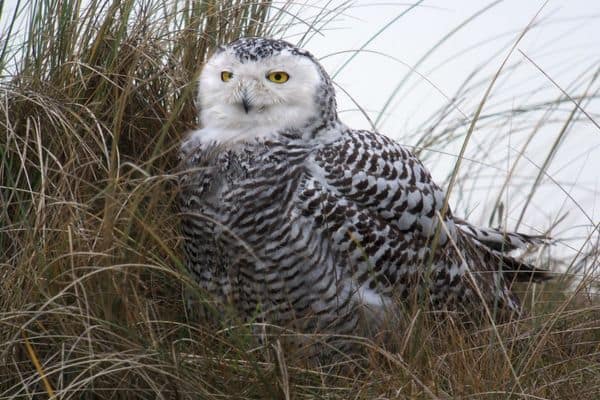
The Snowy Owl exhibits fascinating behaviors that contribute to its unique characteristics. These owls are typically solitary birds, except during the breeding season. They are highly territorial and defend their nesting sites vigorously against intruders, displaying aggressive behaviors and vocalizations to protect their young.
Snowy Owls are known for their exceptional hunting skills. They are patient predators, relying on their keen eyesight and excellent hearing to locate prey. They often perch on elevated areas, such as rocks or posts, scanning the surroundings for any signs of movement. Once they spot their target, they swoop down with remarkable speed and accuracy to capture it.
In addition to their hunting prowess, Snowy Owls are also known for their adaptability. They can endure harsh Arctic conditions and are capable of withstanding extremely low temperatures. During the breeding season, they perform elaborate courtship displays, which include aerial acrobatics and vocalizations, to attract mates.
Snowy Owls are mostly diurnal, meaning they are active during both day and night, particularly during the breeding season when they have to hunt and care for their young. However, they may show more hunting activity during daylight hours in their Arctic habitats.
Habitat
The Snowy Owl inhabits a unique and specific habitat. They are adapted to thrive in Arctic and subarctic regions, including tundra and open grasslands. These habitats provide the perfect environment for the owls to blend in with their white plumage and hunt their preferred prey.
Snowy Owls are often found in areas with low vegetation, where they can perch on mounds, rocks, or other elevated spots to survey their surroundings. These open habitats offer them unobstructed views, enabling them to spot prey from a distance.
During the breeding season, Snowy Owls nest on the ground, typically choosing elevated areas such as mounds or rock outcrops. These locations provide a vantage point for observing their surroundings and protecting their nests from potential threats.
Their Arctic habitat is characterized by long, harsh winters with freezing temperatures and limited food resources. Despite these challenging conditions, Snowy Owls have evolved to endure the cold, relying on their thick plumage and large body size to conserve heat. They are also known to withstand strong winds and can perch on exposed locations without losing balance.
Outside of the breeding season, Snowy Owls may migrate to more southern latitudes, venturing into various habitats such as grasslands, coastal areas, and even agricultural fields. These movements are often triggered by fluctuations in food availability in their Arctic range.
Range
The Snowy Owl is not a native species to Hawaii. While they primarily breed in the Holarctic tundra and winter in regions such as the United States, Europe, China, and Korea, their range does not typically include Hawaii. However, rare occurrences have been documented, including a notable sighting of a first-fall male Snowy Owl at the Honolulu Airport in O’ahu on November 24, 2011.
This individual was considered a vagrant, meaning it strayed from its typical range. Despite being present on O’ahu, Snowy Owls are not known to be regularly found or breed on any specific Hawaiian island.
Conservation Status

The Snowy Owl is currently listed as a species of “Vulnerable” on the International Union for Conservation of Nature (IUCN) Red List. This change in conservation status signifies that the species is facing a higher risk of extinction due to various threats and population declines.
Snowy Owls are primarily threatened by habitat loss and degradation in their breeding grounds, climate change affecting their Arctic ecosystems, and disturbance during the nesting period. Additionally, they can be impacted by collisions with vehicles and structures, as well as illegal hunting in some regions.
Conservation efforts are crucial to protect the Snowy Owl, including habitat conservation, research, monitoring, and raising awareness about the importance of conserving this magnificent species.
Interesting Facts
1. Arctic predators
Snowy Owls are well-adapted to life in the Arctic regions and are considered one of the top predators in their ecosystem.
2. Snowy plumage
Snowy Owls have beautiful white plumage that helps them blend seamlessly into their snowy surroundings. However, males may display some dark spots and barring on their feathers.
3. Nomadic lifestyle
Snowy Owls are known for their nomadic behavior, meaning they can migrate over long distances in search of suitable food sources. These migrations are often driven by fluctuations in their primary prey, such as lemmings.
4. Highly territorial
During the breeding season, Snowy Owls become fiercely territorial, defending their nesting sites from potential threats, including other birds and mammals.
Frequently Asked Questions
1. Are Snowy Owls completely white?
While Snowy Owls are known for their white plumage, males may display some dark spots and barring on their feathers. This variation in plumage helps them blend in with their surroundings.
2. How long do Snowy Owls live?
Snowy Owls have a relatively long lifespan, with some individuals living up to 9-10 years in the wild. However, various factors such as predation, food availability, and environmental conditions can influence their longevity.
3. How do Snowy Owls communicate?
Snowy Owls use various vocalizations for communication, including hoots, barks, hisses, and clucking sounds. They also use body language, such as raising their feathers or wing displays, to communicate with other individuals.
